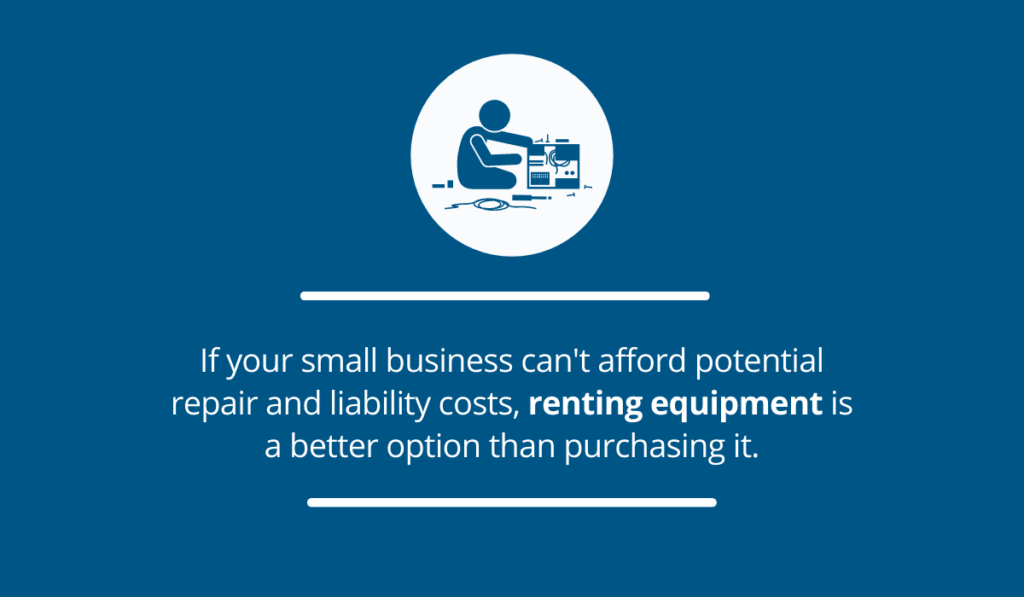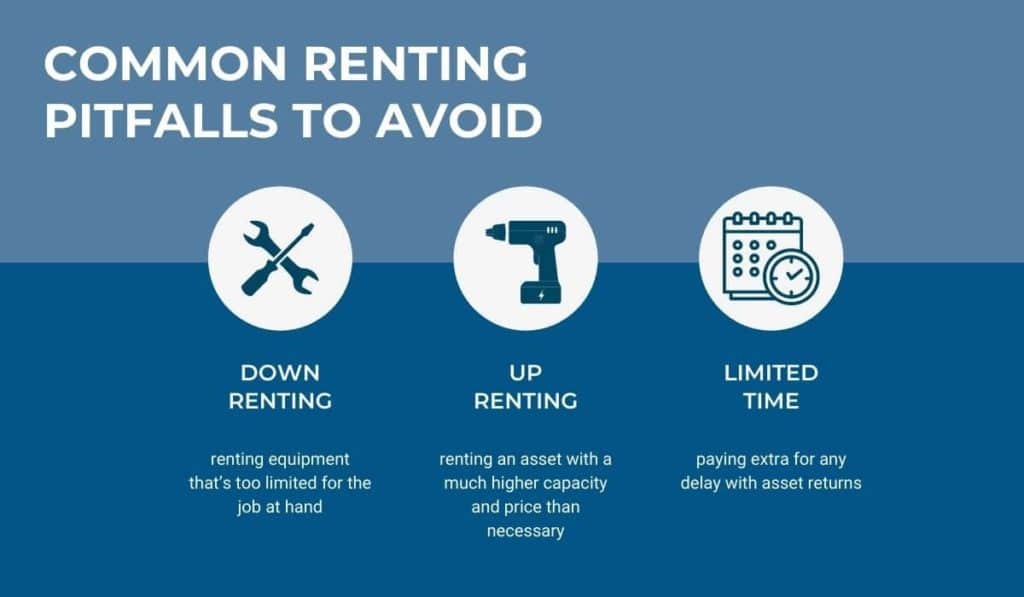To rent or to own, that is the question!
When working with equipment, it’s always tricky to decide whether to invest in purchasing assets or opt for renting.
Clearly, both options have their pros and cons, or you wouldn’t be reading this.
This article will delve into the benefits and downsides of each option while focusing on certain make-or-break factors. In the end, we’ll offer some advice to help you decide.
In this article...
Factors to Help You Decide Between Renting and Owning Equipment
When deciding whether to buy or rent, you will definitely consider factors such as price, urgency, and use.
But, there are several other important aspects to consider.
Each of the following points could sway your decision in either direction, depending on your company’s goal and possibilities.
Let’s go over them!
Usage Frequency
The first thing to consider when deciding how to get equipment is how long you’ll need it.
Of course, if you’ll only need an asset short-term, it’s cheaper and easier to simply rent it.
However, if you’re more likely to use the piece of equipment in most of your projects, it would be wiser to invest in purchasing it.
How can you decide? Let equipment utilization help you.
The average number of working hours per month is 176 (or 22 days). Once you know this, you can calculate an asset’s usage rate:
(equipment working hours per month / 176) x 100
If your rate is below 40%, you’re better off renting the asset. But, if you score above 60%, the better business decision would be purchasing.
To learn more about how to track and improve your equipment utilization, check out this article.
Calculate equipment usage to make a wiser financial decision about renting vs. buying.
Initial Costs
Before deciding whether to rent or buy, always consider the costs.
Owning equipment is a lot more costly than renting in terms of the initial investment. When you buy an asset, you have to pay a lot more upfront than you would to a rental company.
If the equipment is too expensive to buy right away, you might have to get a loan or offer a downpayment and pay the rest later.
On the other hand, if you opt for renting, you will have to pay for the equipment based on how long you will need it. Some companies may offer you a better deal the longer you use the asset.
Are you willing to go into debt to purchase an asset?
In case you’re tight on cash or credit, rental is the way to go.
Understanding what you can afford helps you choose the most viable option for your business.
Willingness to Risk
What kind of risks are you willing to take?
That is the question you should ask yourself when figuring out what option is best for your company.

Smaller companies often can’t afford costly repairs and liability, which is why they tend to choose to rent. In case of an accident, the rental company is in charge of repairing the asset and taking liability.
On the other hand, companies with significant revenue see liability and repairs as less risky since they can afford the expenses, safe in the knowledge that they have immediate access to a piece of equipment as soon as they need it.
After all, insurance and repairs represent a small fraction of their income.
Because of this, they get more value out of owning equipment than renting it.
What about you? Think about whether you can afford to fix an asset when it breaks down, or be held accountable for an accident.
Weigh the possible risks when deciding to rent or purchase equipment.
Downtime
Will downtime make or break your project?
If the answer is yes, you’re better off renting equipment. In case of a malfunction, the rental company will fix the issue on the spot or replace the asset immediately.
Either way, you will avoid unplanned downtime, project delays, and unnecessary costs.
On the other hand, if you can afford a certain amount of downtime, buy the equipment instead. However, make sure you have a plan B in case an asset breaks down.
It is a good idea to:
- have a fantastic maintenance team to fix the issue and have all the spare parts ready
- have a replacement asset to ensure you’re never wasting time
- rent the equipment while your own is in repair
Think of your company’s budget and options. If you can afford any of the three things mentioned above, you can buy equipment without worrying about extra costs.
Think of the possible downtime costs and solutions to decide whether you can afford a purchase.
Environmental Compliance
Air quality standards should be among the factors to sway your decision between owning and renting.
If you lack the resources to worry about environmental compliance, renting is the best option. After all, the rental company has to take care of their fleet’s compliance, which means you can use the assets without a care in the world.
However, if you already own equipment and follow your state and national environmental regulations, you have nothing to worry about. Having another asset to consider won’t be that much of a hassle.
When purchasing new assets, think about compliance—do you need a permit for the equipment? On top of that, you might need to get certifications to use the tool.
Whatever you do, always consider the environmental regulations and make sure to integrate environmental compliance into your business plans. That way, the costs won’t come as a surprise.
Access to the Newest Equipment
How important is it for you to have the latest assets?
If it’s a priority, renting might be a better choice. After all, you can pick the newest model of a particular asset whenever you need one.
Renting also allows you to test more models and decide which one fits your needs best.
However, if you don’t care about the latest trends and have a preferred model you regularly use, why not just buy it? Of course, as long as a purchase is otherwise viable for your business.
Keep in mind that having the latest models of particular equipment at your disposal can be an advantage when bidding for projects.
On the other hand, if you’ve established a name for yourself and have a long history of quality work, you can get away with using older assets.
If having the newest equipment is a priority, you should rent.
Your Credit Score
Credit scores can significantly affect your purchasing options.
The higher your score, the more possibilities you have. After all, vendors check your credit before making a deal—they want to be sure that you will pay for the asset.
If your score is under 550, you won’t get good deals, as unfair as it sounds. You might not even be able to buy expensive equipment because the vendor will be afraid you will fail to pay them.
But, if you score above 750, you’re a reliable payer. Vendors will offer competitive interest rates and repayment terms, giving you a good deal.
If you have a low score but want to buy equipment, here’s how to improve it:
- never miss payments
- pay off any debts you might have
- open an account that reports to credit bureaus
- limit the number of accounts
When deciding between renting and owning, don’t forget to look into your credit score.
Storage and Transport Costs
When you own equipment, you have storage and transport costs to consider.
This might seem obvious, but is often overlooked when buying new assets, when all you want is to get the equipment and use it on your project to get the job done faster.
Also, don’t forget the transport! Can you afford to haul the asset from one location to the next after you buy it—not once, but for every project?
There’s more to organizing transport than mere costs. Someone has to arrange how the equipment will be utilized from location to location to ensure it is as cost-effective and efficient as possible.
What about storage? Buying equipment when your company doesn’t have enough room for it isn’t a good business decision. It will force you to either rent out a storage room (incurring further costs) or sell the asset. In that case, why buy it in the first place?
Limited storage space and transport options will steer you away from buying equipment.
Waiting Time
Think of how much time you have to spare before deciding to buy or rent assets.
When you own the equipment, it’s up to you to arrange the schedule, so the asset is free to use when you need it. Any kind of delay causes further setbacks on other projects, increasing costs and wasting everyone’s time.
If you rent a piece of equipment, you arrange for the delivery on a specific date. Choose a reliable company that will deliver the equipment as agreed.
What can you do if you own assets but want to stay on top of how you use them?
Use software to track and schedule equipment use. That way, you’ll always know when an asset is available, allowing you to plan around it and avoid wasting time.
Time is money, even more so at the worksite.
What to Look Out for When Renting Equipment
If you’ve opted for renting, there are some factors you need to keep an eye on.
Here are the most common renting pitfalls:
- down renting: being offered equipment that’s too limited for the job at hand
- up renting: when the asset has a much higher capacity—and price—than necessary
- a limited amount of time: paying extra for any delay with asset returns
To avoid down or up renting, you need to have a thorough understanding of what type of equipment you need for the job.
Some providers might try to down or up rent to make a profit. However, if you know what you need, you won’t accept an unsuitable offer.
If you’re unsure of what equipment capacity you need, keep your options open and visit several providers. You’ll get to compare prices and the type of assets offered.
Of course, the best option is to find a trusted rental provider and stick with them. A provider gets bonus points if they have knowledgeable employees—they’ll know the best choice for your worksite needs!

The most challenging obstacle to full control is limited time. It depends on a variety of factors, like the skill level of your staff, equipment reliability, weather conditions, and proper management.
The first thing you should do is invest in employees—have skilled teams on the field, expert operators, and competent managers. That way, everyone will do their part to stick to the schedule.
If they don’t, the managers will easily find a way to get back on track and notify you of the possible delay.
A thorough understanding of what your project needs helps you get a good deal when renting equipment.
What to Pay Attention to When Owning Equipment
Of course, owning equipment comes with a price as well.
Some of the aspects to consider when you opt for purchasing assets are:
- ownership cost: the total expenses of owning, storing, and maintaining equipment
- depreciation: the fact that the investments lose value each year
- business growth: buying means growing your business, which comes with extra costs
- theft/misplacement: owning lots of assets carries with it the risk of losing them
You can’t eliminate ownership costs, but you can prepare for them. Before purchasing, sit down with your financial advisors and discuss the expected expenses.
Don’t forget to think of maintenance, storage, transportation, insurance, and downtime costs.
Then, consider depreciation. An asset you pay $20,000 might be worth $5,000 after a couple of years. Is the purchase cost-effective for your business?
Business growth isn’t complicated if you track your expenses and budget wisely.
Think of it like this—when you buy new equipment, you’re expanding your fleet. You have to train your operators to safely use, store, and repair the items. You might even have to hire more employees.
Then, you have to factor in the risk of equipment theft or loss. If you can’t find an asset you need to keep the project going, you’ll have to acquire one.
Tracking your equipment helps you manage those risks. Nowadays, you can tag your assets with QR codes to always know where they are and who is using them.
Take all costs related to owning, purchasing, and tracking assets into account before you buy new equipment.
Conclusion
Choosing between owning equipment and renting it isn’t as easy as it might seem at first glance.
When making this decision, you should consider how often you need the asset, how good your credit score is, and how important it is for you to have state-of-the-art equipment. Factor in the costs of downtime, compliance, and waiting time too.
If you choose to rent, find a reliable provider to avoid up or down renting. In any case, pay attention to the underlying costs and track your equipment to get the most out of it!




